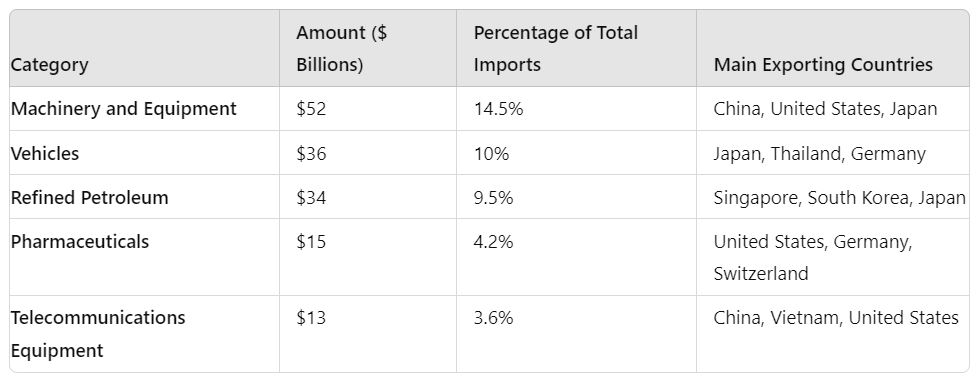Main Exports of Australia
 Iron Ore
Iron Ore
Iron ore is the backbone of Australia’s export economy, playing a crucial role in its GDP. In 2023, the country exported iron ore worth approximately $133 billion, representing nearly 24% of its total exports. China takes the lion’s share, importing over 80% of Australia’s iron ore, followed by Japan and South Korea. This mineral resource is vital to global steel production, making Australia a key supplier due to its rich deposits and proximity to major Asian markets.
Coal
Coal remains one of Australia’s top exports, vital for its energy and mining sectors. In 2023, coal exports, including both metallurgical and thermal coal, reached around $63 billion, accounting for 11.5% of the total exports. Major importers include Japan, India, and China. Australia’s high-quality coal is indispensable for electricity generation and steel manufacturing, strengthening its position as a global leader in coal exports.
Natural Gas
Australia has emerged as a leading exporter of liquefied natural gas (LNG), with exports valued at approximately $47 billion in 2023, making up 8.5% of total exports. Key importing nations include Japan, China, and South Korea. The expansion of LNG projects within the country has solidified its status as a critical player in meeting Asia’s demand for cleaner energy alternatives.
Gold
Gold is another significant export for Australia, with export values nearing $29 billion in 2023, constituting 5.3% of the nation’s total exports. The United Kingdom, Hong Kong, and China are the primary importers of Australian gold. Supported by rich deposits in Western Australia, the gold mining sector continues to thrive, driven by global demand for both investment and industrial purposes.
 Beef
Beef
Australia is renowned for its beef exports, amounting to $9.5 billion in 2023 and comprising 1.7% of the total exports. Major markets include Japan, the United States, and South Korea. Known for its high quality and safety, Australian beef meets global demand for premium protein, bolstering its reputation in the international food industry.
These exports are pivotal to Australia’s economy, underscoring its status as a major global trading nation.
Strategy and Analysis of Australia Exports
Understanding the strategy behind Australia’s export success is crucial for industry stakeholders. The country’s focus on leveraging its natural resources, maintaining high-quality standards, and fostering strong trade relations with key markets has been instrumental. This strategic approach not only boosts economic growth but also ensures a steady demand for Australian commodities on the global stage.
Main Imports of Australia Machinery and Equipment
Machinery and Equipment
Machinery and equipment represent Australia’s largest import category, valued at approximately $52 billion and accounting for 14.5% of the nation’s total imports. Primary exporters to Australia include China, the United States, and Japan. The imported machinery ranges from industrial and mining equipment to electrical machinery and telecommunications devices, essential for the country’s infrastructure, manufacturing, and services sectors.
Vehicles
Vehicles, including cars, trucks, and other transport equipment, are significant imports for Australia. In 2023, vehicle imports were valued at around $36 billion, representing 10% of total imports. Major exporters are Japan, Thailand, and Germany. Due to its relatively small domestic automotive manufacturing industry, Australia relies heavily on imported vehicles to meet both consumer and commercial demands.
Refined Petroleum
Refined petroleum is crucial for Australia’s energy needs, with imports totaling approximately $34 billion, making up 9.5% of total imports. Key suppliers include Singapore, South Korea, and Japan. Australia imports refined petroleum products such as gasoline, diesel, and aviation fuel to power its transportation sector and support various industries nationwide.
Pharmaceuticals
Pharmaceutical products are vital imports for Australia, valued at nearly $15 billion in 2023, accounting for 4.2% of total imports. The main exporting countries are the United States, Germany, and Switzerland. Australia’s healthcare system depends on these imports to provide advanced medical treatments and maintain the health and well-being of its population.
 Telecommunications Equipment
Telecommunications Equipment
Telecommunications equipment, including mobile phones, network devices, and other communication technologies, is a major part of Australia’s imports. In 2023, these imports were valued at approximately $13 billion, representing 3.6% of the total imports. The primary exporting countries are China, Vietnam, and the United States. The growing demand for advanced communication technologies in both personal and business sectors drives this category.
Strategy and Analysis of Australia Imports
Australia’s import strategy focuses on fulfilling the country’s technological, industrial, and healthcare needs. By importing high-quality machinery, vehicles, refined petroleum, pharmaceuticals, and telecommunications equipment, Australia ensures it remains competitive and meets the demands of its growing economy. This strategic importation supports various sectors, driving overall economic stability and growth.
 Conclusion
Conclusion
Australia’s trade dynamics provide a fascinating look at how the country uses its natural resources and strategic imports to strengthen its economy. For freight forwarders, logistics providers, importers, exporters, customs brokers, manufacturers, and e-commerce businesses, understanding these trade patterns is crucial for optimizing operations and uncovering new market opportunities.
The relationship between Australia’s key exports—iron ore, coal, natural gas, gold, and beef—and its major imports of machinery, vehicles, refined petroleum, pharmaceuticals, and telecommunications equipment highlights its strong trade framework. By staying informed and aligned with these trends, businesses can position themselves for success in this dynamic market.
For those looking to deepen their knowledge and leverage these insights, partnering with experts can help navigate the complexities of international trade. Stay ahead and ensure your business thrives in the competitive landscape of global commerce.





 Iron Ore
Iron Ore Beef
Beef Machinery and Equipment
Machinery and Equipment Telecommunications Equipment
Telecommunications Equipment Conclusion
Conclusion



